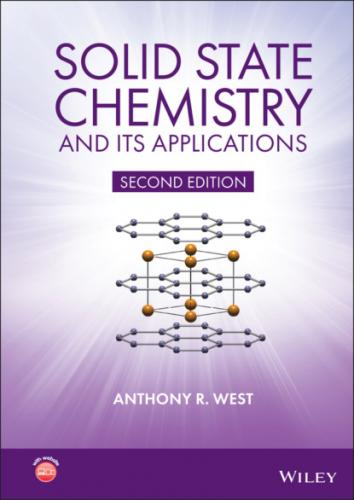The unit cell of NaCl in three dimensions is shown in Fig. 1.2; it contains Na at the corner and face centre positions with Cl at the edge centres and body centre. Each face of the unit cell looks like the unit area shown in Fig. 1.1(c). As in the 2D case, the choice of origin is arbitrary; an equally valid unit cell could be chosen in which Na and Cl are interchanged. The unit cell of NaCl is cubic. The three edges: a, b and c are equal in length. The three angles: α (between b and c), β (between a and c) and γ (between a and b) are all 90°. A cubic unit cell also possesses certain symmetry elements and these, together with the shape define the cubic unit cell.
Figure 1.2 Cubic unit cell of NaCl, a = b = c.
Table 1.1 The seven crystal systems
| Crystal system | Unit cell shapeb | Essential symmetry | Allowed lattices |
|---|---|---|---|
| Cubic | a = b = c, α = β = γ = 90° | Four threefold axes | P, F, I |
| Tetragonal | a = b ≠ c, α = β = γ = 90° | One fourfold axis | P, I |
| Orthorhombic | a ≠ b ≠ c, α = β = γ = 90° | Three twofold axes or mirror planes | P, F, I, A (B or C) |
| Hexagonal | a = b ≠ c, α = β = 90°, γ = 120° | One sixfold axis | P |
| Trigonal (a) | a = b ≠ c, α = β = 90°, γ = 120° | One threefold axis | P |
| Trigonal (b) | a = b = c, α = β = γ ≠ 90° | One threefold axis | R |
| Monoclinica | a ≠ b ≠ c, α = γ = 90°, β ≠ 90° | One twofold axis or mirror plane | P, C |
| Triclinic | a ≠ b ≠ c, α ≠ β ≠ γ ≠ 90° | None | P |
a Two settings of the monoclinic cell are used in the literature, the most commonly used one given here, with b as the unique axis and the other with c defined as the unique axis: a ≠ b ≠ c, α = β = 90°, γ ≠ 90°.
b The symbol ≠ means ‘not necessarily equal to’. Sometimes, crystals possess pseudo‐symmetry. For example, a unit cell may be geometrically cubic but not possess the essential symmetry elements for cubic symmetry; the true symmetry is then lower, perhaps tetragonal.
The seven crystal systems listed in Table 1.1 and shown in Fig. 1.3 are the seven independent unit cell shapes that are possible in three‐dimensional (3D) crystal structures. Six of these unit cell shapes are closely inter‐related and are either cubic or can be derived by distorting a cube in various ways, as shown in Fig. 1.3(b).
Thus, if one axis, c, is of different length to the others, the shape is tetragonal; if all three axes are different, the shape is orthorhombic. If, now, one of the angles, β, is not 90°, the shape is monoclinic, whereas if all three angles differ from 90°, the shape is triclinic. Finally, if the cube is stretched, or compressed, along a body diagonal so that all three angles remain equal, but different from 90°, the shape is trigonal.
The remaining unit cell shape is hexagonal. A hexagonal‐shaped box is shown in Fig. 1.3(a) and discussed later with reference to Fig. 1.21, but the true unit cell is only one‐third of this size, as shown.
Although it is common practice to describe unit cells by their shapes, it is more correct to describe them by the presence or absence of symmetry. Thus, for example, if a unit cell has four intersecting threefold axes, it must be cubic in shape; the reverse does not necessarily apply and the unit cell could be fortuitously cubic but not have the threefold symmetries in the atomic arrangements. The essential symmetry for each crystal system is given in the third column of Table 1.1. Let us deal next with symmetry.
1.2 Symmetry
1.2.1 Rotational symmetry; symmetry elements and operations
Symmetry is most easily defined using examples. Consider the silicate tetrahedron shown in Fig. 1.4(a). If it is rotated about an axis passing along the vertical Si–O bond, then every 120° the tetrahedron finds itself in an identical position. Effectively, the three basal oxygens change position with each other every 120°. During a complete 360° rotation, the tetrahedron passes through three identical positions. The fact that different (i.e. >1) identical orientations are possible means that the SiO4 tetrahedron possesses symmetry. The axis about which the tetrahedron may be rotated is called a rotation axis; it is an example of a symmetry element. The process of rotation is an example of a symmetry operation.
Figure 1.3 (a) The seven crystal systems and their unit cell shapes; (b) five of the seven crystal systems can be derived from cubic by structural distortions.
Figure 1.4 (a) Threefold and (b) twofold rotation axes; (c) the impossibility of forming a complete layer of pentagons; (d) a complete layer of hexagons.
The symmetry elements that are important in crystallography are listed in Table 1.2. There are two nomenclatures for labelling them, the Hermann–Mauguin system used in crystallography and the Schönflies system
